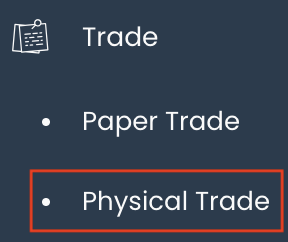...
...
...
...
...
...
...
...
...
...
...
...
...
...
...
...
...
...
...
...
...
...
...
...
...
...
...
...
...
...
You will be able to add new trade(s) and enter its details directly into your portfolio by clicking 'Add Trade' EDIT PORTFOLIO
Any trades that are in the portfolio will be highlighted in blue. If you wish to remove any trade(s), tick the checkbox (represented by a '+' blue box with a tick' icon) . You and it will be directed to the 'Create New Paper Trade' page to enter your trade details. This process is the same as Capturing & Allocating of Trades.
These newly-created trade(s) will automatically be allocated into your selected portfolio.
Please refer to Add New Trades into Portfolio for more details.removed from the portfolio.
If you wish to allocate any other existing trade(s) into your portfolio, select the checkbox (represented by an 'empty box' icon) to select your desired trade.
Please note that you cannot add trades into a parent portfolio. This is because a parent portfolio is used to compute the overall performance of its sub-portfolios and must be left empty (no trades added) for this purpose.
Please also note that you cannot add a physical trade into your portfolio. Each newly created physical trade will automatically generate its own portfolio and you may add your paper trades from there.
4. Select the trade(s) to be included in the newly-created portfolio. The list includes trades that are already recorded in your account. If you want to include trades that are not found in this list, you may first input your trades under 'Paper Trade' from the navigation sidebar on the left. Otherwise, for your convenience, you may choose to create an empty portfolio first, and capture trades into it later on by directly creating new trade(s) here.
...
All the steps in creating physical trade is the same using SPOT (Contract Type), the only difference is deciding whether you want to add the trade as part of the TERM contract. To decide if you want to use the SPOT or TERM method, if you want the system to keep track of how much quantity has been traded and outstanding (especially when you have not received the subsequent contract yet and is unsure of the actual quantity and price etc) for that contract, then you select TERM. So if you allocate the trade to the term contract, the system will accumulate the quantity into the traded quantity and reduce outstanding quantity accordingly. The outstanding quantity determines the quantity that has not been fulfilled for the contract.
Note: You can choose not to use the TERM method, but you may not be able to know if the main contract has been fulfilled/completed and may need to manually calculate the total quantity to determine its fulfilment.
To access the 'Physical Trade' page, click 'Trade' from the navigation sidebar on the left, followed by 'Physical Trade'.
TABLE OF CONTENTS:
| Table of Contents | ||||
|---|---|---|---|---|
|
...


